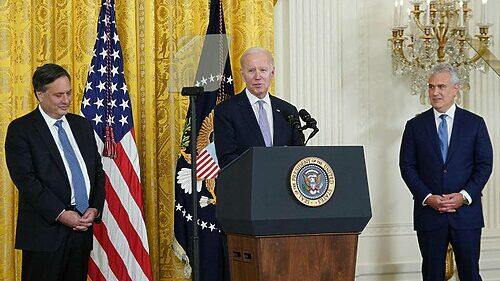
MANDEL NGAN / AFP via Getty Images
Being a member of the presidential Cabinet can be a high-stress job, no matter who is sitting in the Oval Office. So it makes sense that just over two years into President Biden’s administration, some of his initial appointees are heading for the exits. Last Tuesday, it was reported that Secretary of Labor Marty Walsh would resign to become executive director of the NHL players’ union. And Wednesday was Ron Klain’s last day as White House chief of staff.
Presidents can designate other important administration posts, such as chief of staff, as “Cabinet-level,” on par with the Cabinet secretaries.
">1But compared with other modern presidents (especially his immediate predecessor), Biden’s Cabinet has had unusually low turnover. Biden is tied with former Presidents Jimmy Carter and George W. Bush for the fewest Cabinet resignations in the first two years of their presidencies.
Carter’s lone loss was Office of Management and Budget Director Bert Lance in September 1977. For Bush, it was former Secretary of the Treasury Paul O’Neill, who left in December 2002.
">2 For Biden, Klain was just the second Cabinet-level official to quit. Former Office of Science and Technology Policy Director Eric Lander resigned in February 2022. But that job wasn’t even part of the president’s Cabinet until Biden elevated it to that position. If Biden had not promoted the OSTP director to Cabinet level, he would have gone his first two years with no turnover in his Cabinet — something that hasn’t happened since at least the late 1970s.The chart below shows how many people resigned from one of the 25 offices that constitute Biden’s Cabinet
Different presidents have designated different offices to be in the Cabinet. In addition to the vice president and the heads of the 15 Cabinet departments, Biden’s Cabinet includes the chief of staff, the chair of the Council of Economic Advisers, the director of national intelligence, the OSTP director, the administrator of the Small Business Administration, the ambassador to the United Nations, the U.S. trade representative, the administrator of the Environmental Protection Agency and the director of the Office of Management and Budget. In order to make an apples-to-apples comparison with Biden, we’ve included all of these offices in the chart below even if they weren’t in the Cabinet during the administration in question — and we didn’t include offices that were in that president’s Cabinet but aren’t in Biden’s.
">3 in each year of the past eight presidential administrations. It doesn’t include “acting” Cabinet members who stepped aside for permanent appointees, but it does show when someone resigned from one Cabinet position to assume another.Biden’s administration looks like the model of stability next to most of these guys — and especially next to former President Donald Trump. Trump burned through personnel at a record rate: He is the only recent president to have lost more than one Cabinet member during his first year in office (he lost three). And he saw eight people leave these 25 posts during his second year, more than any other recent president. All that turnover contributed to a narrative of chaos and mismanagement in the Trump administration, one that Biden sought to capitalize on when he challenged Trump in 2020; as Politico Magazine wrote at the time, the country voted to “make politics boring again.” Based on the stability of his administration, Biden has succeeded.
At least so far. As the chart also makes clear, Cabinet turnover tends to increase midway through a president’s first term.
And, even more dramatically, at the beginning of a president’s second term if he is reelected.
">4 The average presidential administration from Carter to Trump saw 0.7 people leave these posts in the first year and 3.6 people leave in the second year; however, an average of 4.7 people left in year three. So it’s reasonable to assume that more Cabinet members will follow Klain and Walsh out the door in the coming months. But when they do, it won’t be a sign of turmoil within the Biden administration, just normal turnover for this point in a president’s term. After all, nearly every one of Biden’s advisers have been toiling away for more than two years now — and these jobs ain’t easy.Maya Sweedler contributed research.
Footnotes
Presidents can designate other important administration posts, such as chief of staff, as “Cabinet-level,” on par with the Cabinet secretaries.
Carter’s lone loss was Office of Management and Budget Director Bert Lance in September 1977. For Bush, it was former Secretary of the Treasury Paul O’Neill, who left in December 2002.
Different presidents have designated different offices to be in the Cabinet. In addition to the vice president and the heads of the 15 Cabinet departments, Biden’s Cabinet includes the chief of staff, the chair of the Council of Economic Advisers, the director of national intelligence, the OSTP director, the administrator of the Small Business Administration, the ambassador to the United Nations, the U.S. trade representative, the administrator of the Environmental Protection Agency and the director of the Office of Management and Budget. In order to make an apples-to-apples comparison with Biden, we’ve included all of these offices in the chart below even if they weren’t in the Cabinet during the administration in question — and we didn’t include offices that were in that president’s Cabinet but aren’t in Biden’s.
And, even more dramatically, at the beginning of a president’s second term if he is reelected.
Nathaniel Rakich is a senior elections analyst at FiveThirtyEight. @baseballot
Alex Newman is FiveThirtyEight’s senior editor for interactives.
Comments
Read More















